#taxi collectivo
Text
Max, Panama, Tag 16
Es ist zu heiß für den Klassenkampf
Heute morgen wollten wir recht früh los, um in den Nordosten der Insel zu fahren und dort den Dschungel und die Strände zu erkunden. Deswegen setzten wir uns an den Sammelpunkt des Collectivos und warteten. Und warteten. Etwa 1,5 Stunden vergingen und wir packten unsere Sachen, um den Weg zu Fuß zu gehen. Was, wären wir direkt losgelaufen, vielleicht noch möglich gewesen wäre, war es zur Mittagszeit aber so ganz und gar nicht. So stoppten wir nach wenigen Kilometern an einem Café, um eine kleine Pause einzulegen. Dort erfuhren wir, dass diese Strecke „wahrscheinlich“ bestreikt wird. Bei gefühlten 42 Grad (das ist keine meiner typischen Übertreibungen, auch der Wetterdienst sah das so), haben wir also entscheiden, dass es besser ist, wieder umzukehren und den Tag einfach mal Tag sein zu lassen.

Wir nahmen ein Taxi und dachten uns etwas wie „wenn man schon nichts schafft, soll man wenigstens gut essen“ - es gab Hummer und unser Plan ging damit offensichtlich voll auf.
Ansonsten war die Speisekarte recht ausgedünnt. Die Dame, die den kleinen Schuppen in Eigenregie betreibt, erinnerte uns an die Blockaden. Nicht nur bei ihr, sondern auch bei bisher ausnahmslos allen fällt mir dabei eine Sache positiv auf: es scheint, als wären die Menschen in Panama entweder a) deutlich besser darin als Deutsche, mit Situationen umzugehen, die nicht in ihrer Hand liegen und deswegen nicht völlig auszuflippen oder b) in der Lage, tatsächlich politische Zusammenhänge zu verstehen und keine „Täter-Opfer Umkehr“ zu betreiben. Wie viele Bilder habe ich gesehen von irgendwelchen Durchgeknallten, die mit ihren SUVs die „Klimakleber“ anfuhren oder online mit Gewaltfantasien um sich schmissen. Versteht mich nicht falsch, ich finde die „letzte Generation“ ziemlich beschissen. Aber Klimaschutz finde ich erstmal gut. Auch Druck auf die Politik, die in der Thematik völlig versagt und während Leute wie Neymar oder andere Abertausende alleine im Privatjet von Brasilien nach Saudi-Arabien pendeln um dort das Blutgeld zu verdienen lieber an „Verpflichtungen des Einzelnen“ appelliert und der Arbeiterklasse den Sommerurlaub madig redet… ach wisst ihr was, das regt mich alles zu sehr auf.
Daher vielleicht noch ein anderes aktuelles Beispiel: Streiks der GDL. Auch hier nicht falsch verstehen - ich wollte schon einer Menge Schaffnern oder Lokführern ordentlich eine reinhauen. Ganz sicher aber nicht dann, wenn sie für ihre Rechte einstehen und die Bahnen eben mal ein paar Tage nicht fahren. Die Leidtragenden sind aber sie, wenn der deutsche Mob es mal nicht pünktlich zur Arbeit schafft. Statt sich mit den Streikenden zu solidarisieren und den Forderungen an die DB öffentlich Nachdruck zu verleihen, werden die Ausgebeuteten zu Schuldigen verklärt. Nicht so hier, wo trotz allem Kundgebungen in Solidarität zum Streik stattfinden. Stellt euch mal vor, alle Autobahnen wären seit drei Wochen von „Klimaklebern“ blockiert. Ich mag mir nicht ausmalen, wie die Diskussionen und auch die Gewalt eskalieren würden.

Hier nochmal ein Screenshot aus einem heimlich gefilmten Video einer der Blockaden. Nicht im Bild: verbrannter Boden und fette Stahlseile in 1,5 Metern Höhe gespannt. Hinten im Bild: Spruchbänder, die Korruption und soziale Ungleichheit kritisieren.
Naja, nach dem Hummer jedenfalls haben wir uns getreu unseres für den Tag ausgerufenen Mottos einen Frappé am Meer genehmigt und die Zeit verplempert, bis wir eine „Bioluminiszenz-Tour“ gemacht haben. Dabei wurde Plankton in einer Bucht kurz angeleuchtet, das daraufhin blau leuchtete, was zum Teil wirklich atemberaubend schön aussah und das ganze Boot umringte, viele viele Meter weit. Dadurch, dass es angeleuchtet werden muss um in der Folge zu reagieren meint Nico, es würde sich vermutlich eher um Photoluminiszenz handeln, der chemische Zusammenhang ist aber noch nicht ganz geklärt. Bei Rückfragen wendet euch bitte nicht an mich. Meine Gedanken dazu waren nämlich „Blau. Höhö.“


Morgen versuchen wir es nochmal mit der anderen Seite der Insel. Wenn das nichts wird, halt wieder zum Playa Estrellas. Ich kann mir Schlimmeres vorstellen.
3 notes
·
View notes
Text
Last Morning in Flores
I allowed myself a sleep in until 7am since is this meant to be a holiday after all! My breakfast today was at Cool Beans cafe, overlooking the lake. It was a huge pile of fresh pineapple, papaya, banana and melon alongside the French toast and then topped off with a latte. I ate in the company of a little cat and a lizard and then asked the guy working there for advice about the boats because I was going to ride one but didn’t want to get ripped off. He gave me a hand drawn map and told me the price was Q10 but warned that they might charge me tourist prices… with the map in hand I set off to the dock to find my ride. Of course there is no shortage of people shouting, “Hey amigo! Need a ride?” So I could jump into the first boat I saw. The ride was very short, only about 4 minutes to get to the little town of San Miguel on the other side of the lake and amigo charged me Q10, no real ripping off anywhere in Guatemala so far! Following the map I walked twenty minutes across the island to the beach on the other side, Playa Chechenal. Supposedly this is a private beach and an entrance fee is required. I didn’t see anyone taking money so I just poked my head around the shore and then headed back inland. The next destination was the site of an archaeological excavation. I’m not sure exactly what they were excavating but there was also a viewpoint through the trees to the island of Flores. I saw some monkeys on my walk through to the other side and set some dogs off barking as I walked back down to the waterfront. I found some good places for photos with the wharf, boats, and a waterfront sign. Got myself a cold bottle of water for the ride back and then boarded a boat back to where I’d started, I finally found myself a Guatemala magnet that worked for me and then went back to the hotel to shower, pack my bag and check out. The taxi that picked me up to take me to the airport had a woman and child in the front seat so it was definitely a collectivo (shared taxi) but he charged me Q50 when I thought it would be Q25. I just gave it to him since it’s only about $4 anyway! Since I was so early to check in I ditched my bag and then walked to the entrance of the airport to a nicely painted plane. I’d seen a lot of street art on the way into the city from the airport but it was too hot to walk around looking at it so I resigned myself to going through security and sitting quietly to wait for boarding. The terminal building was nice and small, with big windows so you can clearly see the runway. I figured we’d be boarding the same plane that’s flying here so made sure to watch for when it landed! The tiny airport and 30+ heat reminded me of Samoa, I think Fiji had a bigger airport but Samoa was very similar to Flores. One controller headed out with his lightsabers and then about 5-6 bag boys and the cart with everyone’s bags followed. A few people stood at the windows to watch the action of the plane arriving, everyone disembarking, bags coming off, toilet getting emptied, gas getting filled up, bags loaded on and then the gate opening for us. When I arrived in Guatemala City I went to find a place to sit to get my hoodie out and repack my bag. Outside was thunderstorms apparently and I had learned my lesson the first time that once you leave the airport you’re out for good! I sat near the tourist information booth and a presumably American girl asked me if I wanted to share an Uber with her to Antigua. I told her I’d already booked and paid for a shuttle at 7.30pm and she reluctantly paid the $12 for the ride out to Antigua. Even that was a better deal than I got but I was determined to see a slice of Guatemala City and not skip it entirely as most people do...
2 notes
·
View notes
Text

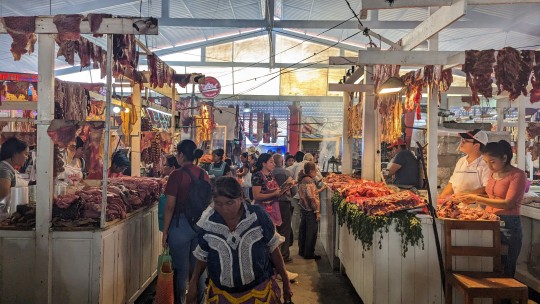
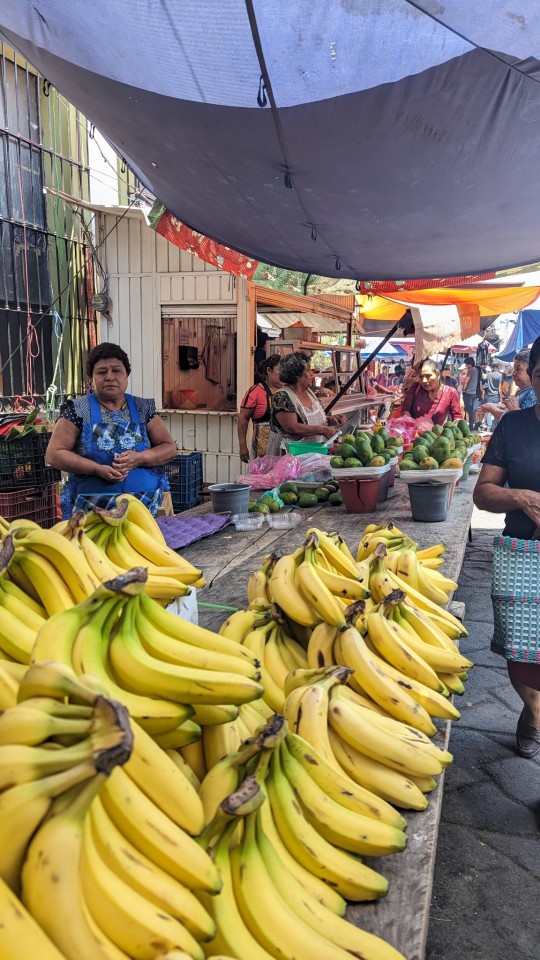
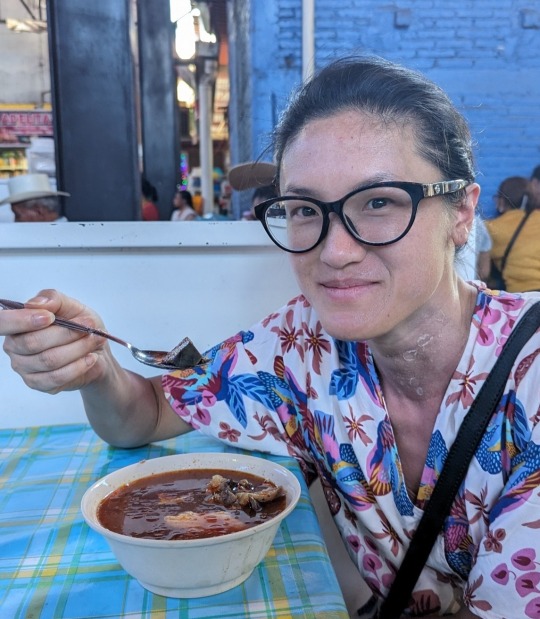
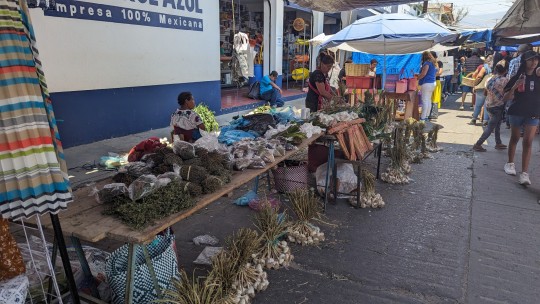

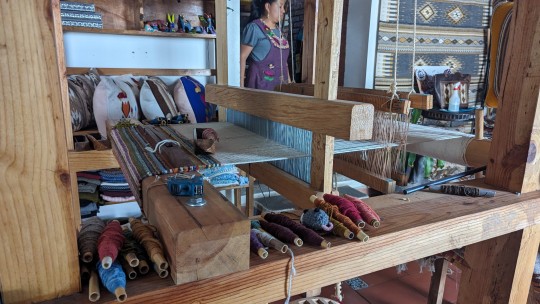



Tlacolula de Matamoros and Teotitlán del Valle
The hostal recommended going to Tlacolula for their big Sunday market. It's 30 min away east of town. There is a collectivo - a shared taxi with red and white colours - parked in Mercado Central to take you for 30 pesos. We mostly went to discover new food. There isn't anything particular to buy there.
On our way back, we stopped by Teotitlan del Valle, the village where most wool products (rugs and bags) are made. I wasn't impressed with the town. But it was Sunday, so that's probably the reason it was so quiet. Most shops were selling the same things you could find in Oaxaca, except for a few studios who do commissions or originals. The benefit of this trip was to understand how they handmade their rugs, and to see their workshops. If you visit this village, just avoid Sundays.
A tuk-tuk will take you from the collectivo stop to the center of the village for 10 pesos.
0 notes
Text
La Reforma:
Way back in the hills , deep in a valley , lies La Reforma, a very small town beside a winding river. Accessible by a rough dirt road that snakes across the cattle stripped hills, this is where the gringos don,t go. Oh they used too, when the road to the waterfalls was intact, and the cabinas there were functional, but neglect and rain have ruined the road, and the stand alone solar system failed for lack of maintenance leaving the cabinas unusable. Too bad, because the waterfall at 100 feet vertical was a wonderful sight, and the rushing stream tumbled over big boulders out of the box canyon into calm swimmable pools. The cabinas were run by volunteers from La Reforma in a bid to bring in tourist dollars, but the food was poor and the road was too bad.
My friends Jimmy(Tortuga) and Tracy were planning to take their motorcycle in to some new cabinas at La Reforma, so i took public transit(sic) to join them. Given many contradictory directions, I found the old bus station uptown and the San Pedro caminettas(collective taxis).Frequent and cheap(26 pesos) . While Puerto has expanded up into the hills, the road remains the same gully twisting paved cow trail.The steep foothill terrain has discouraged development. An optomist had marked out lots(10mby20m) on a 45 degree slope, soon to slide away. Dozen of beehives a re placed off road to catch the last of the rainy season flowering trees. 1 half hour to the crucero, where the collectivos to La Reforma wait. Well i waited in shade on a plank bench, no collectivo. A stream of tuk tuks ferried people from the village nearby to San Pedro, but approached said it was 1 hour to La Reforma, no go.A totally overloaded truck disgorged a vast load of fruit and vegetables into the stand at the corner, and in turn smaller trucks came to pack the food off for distribution to tiendas. Cabbages bigger than basketballs were tossed , leaves flapping ,into the shed, only to be shot putted in to the buyers vehicles moments later. Crates of oranges, hands of bananas, heaps of canteloupe,, piles of potatoes. I was just about to call Jimmy, when they pulled up on their motorcycle with Gaeten on his spiffy 200 alongside. They sat in the shade pulling on beers and just as they were leaving along came a collectivo truck. Not that that meant departure, we had to wait for more passengers to make the trip pay. Only got one more guy but picked up a chica en route and a peon with a Husky chain saw with a 3 foot bar(?). Biggest tree in sight was 1 foot thick. All the hills have been logged, leaving scrub, vines and cow ploughed hillsides. The corn planted in the clearcuts only grows well for a couple of years until the soil is depleted and washed away. Nice cemnt paved road for 2 K then eroded dirt track. Mud dust, dirt, very steep switchbacks with tiny streams rolling down across the dirt at intervals. Terrific (terrifying) views across the valleys to the far mountains, I was admiring the eye level tree tops until I looked down and saw that the tree were 100 feet tall, rising vertical beside the track. too steep to pull out and thus saved. the hill swere green patched with corn , mostly harvested, and jungle vines coated the roadside shrubbery. Despite this abundance of greenery, this is the edge of desert, and cactus poke out of the scrub everywhere. The driver was calm(old) and safe, but he had to carefully navigate the washouts and roadslips dropping 100's of feet vertically into the hillsides. 30 K top speed, often a low gear crawl.
La Reforma after a 1 hour bumpy ride and dropped right at the gate(40P) of Mario Lopez who has built 3 cabinas for rent at the end of the road right beside the river where the stream gushes out of a jumble of big boulders. Here i found my biker buddys, swilling beer and relaxing. The place is run by Marios family, who live in the roadside houses and cook for guests. Pati 954 123 9805. Yes there is WiFi. Cabinas are 400 pesos and food is ok. Very green and shady, dirt paths, friendly but little English. My Spanish is acceptable, and if I rehearse I can ask for most things and make simple conversation. Usually i can pick the verbs out of the replies and guess at the context.
Cabinas, here called Cabanas, are new, brick built,clean, tiled, and have cold water bathrooms and comfy beds. Secure, quiet, restful. The chicken shacks of yesterday have given way to cement and tile, the dogs a re friendly, and the people ,like most rural Mexicans, are curious and friendly if given respect. La Reforma has an elementary school, a high school, basketball court, police station and an ambulance.Pretty good for a town of 1500 spread out along the river valley.No mercado, tiny tiendas with junk food and that's all. Bring food for the cooks, fruit and treats to share .Gramma makes great rice and tortillas, and everyone hangs out in the open air kitchen area. Food is cooked on a comal , wood fired, thought there is a gas stove. Electricity, artesian water(I drank it with no ill effects), caged chickens(no rooster) a quiet discouraged parrot and a puppy. The only sound is the rumble of the river where it tumbles over 10 foot rocks into a deep swimmable pool then froths across gravel and boulders ,perhaps 20 meters wide and up to 1 meter deep downstream to the town. Odd lily like flowers sway in the shallows, white with long narrow petals, safe from goats. The poolis where the local kids walk to for afternoon swimming and fun. They are shy but friendly if spoken to. the cabinas are the only accomodation in town so gringos are a novelty.
Jimmy, as chef , cooked chicken in Panko and cornflakes, cruchy coating, tasty chicken. The chicken came a bit late out of the freezer so dinner was abit late. Next night he cooked Dorado from our fishing trip, delicious! All shared with the family, who were happy to eat so well. Breakfast were cooked by sandra the waitress, maid and friend Huevos Rancheros using the onion and green pepper I brought to share. Surprisingly the slad fixins I packed were still good and Jimmy and Tracy ate sprouts for the first time. For lunch I had boiled eggs I,d brought and grapefruit off the tree(bit dry and tangy, but good). Jimmy says the kitchen food usually tough chicken in mole sauce. Glad we brought supplys.
Rivers talk at night. this one had a voice for every rapid ripple and a bass chorus from the falls.The tone and volume is never the same. Unlike the pulsing heartbeat of beach waves, the river chats and chuckles. Other than the river it was quiet , pitch black at night and felt safe and peaceful Really feels like a different world from urban Puerto. Friendly family, safe place, nice cabinas, great cold swimming hole , an affordable getaway. My total bill for 2 nights, 400pesos per night for the cabina, breakfast 100P and miscellaneous, total900 Pesos. I,ll go again....
0 notes
Text

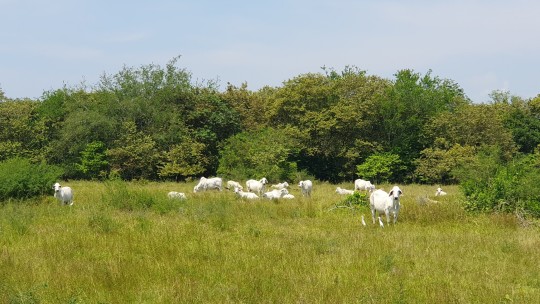

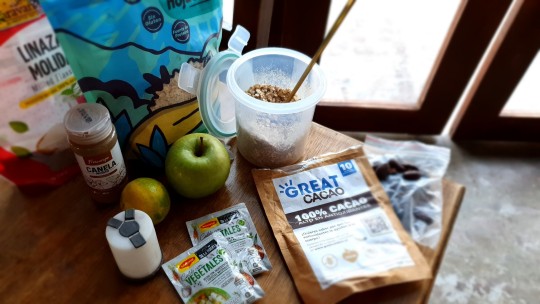
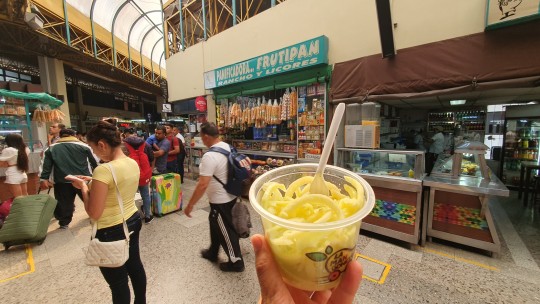
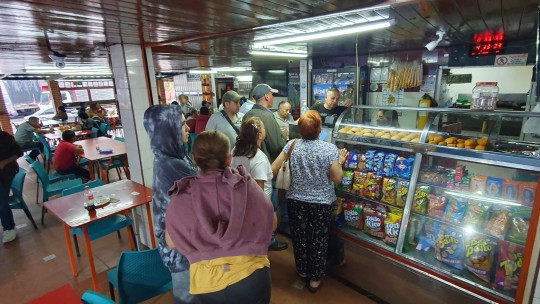
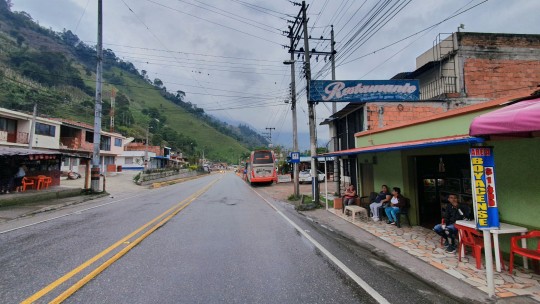
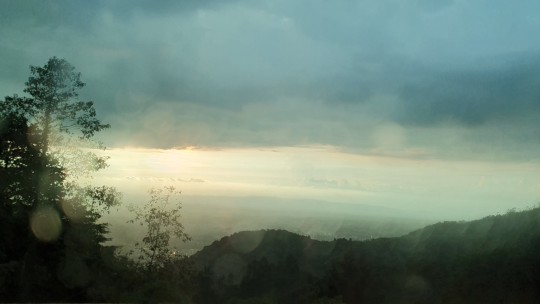
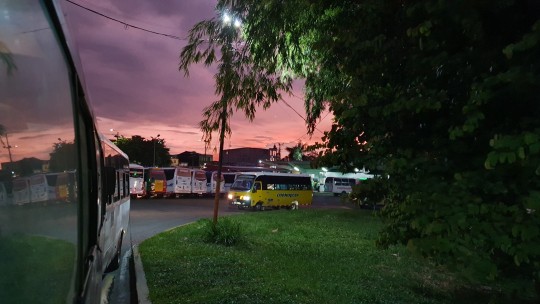

About a travel day ...
origen: Tatacoa Desert
destino: Salento
distancia: 275km
duración del viaje: 13 horas
modos de transporte: 1 private taxi, 2 collectivos / vans, 2 big busses, 1 small public bus
7am. The desert says goodbye with beautiful atmospheric morning light and fresh air after another rainy night. Our guide and driver Maul is taking my two French companions and me to the little village Villavieja, where the girls want to stay for a few hours remote working, and I'll be looking for transport to the Terminal de Transporte in Neiva.
Only 13 hours and 5 more transports later, at 8pm, I am being friendly welcomed to my new hostel and feel very relieved, especially about not having missed the last bus from the town 1hr away to this sweet village.
It has been my most cumbersome and most unpleasant travel day. But I made it, and kept my mood in good balance despite the uncertainty and obstacles throughout the day. And, rewarded myself with a nice dinner, the highly recommended local dish Trucha (salmon-colored trout fish).
Section Neiva - Ibague: Car broken, only 25min before intermediate destination Ibague. For 5min they've ried to repair ot, another 5min later I'm already sitting in the next bus, a big one. Wow. Once again very efficient and adaptive the Colombians, despite obstacles.
It is public holiday, after a long weekend, buses are full, the station is packed. I will need to wait an hour for my next bus to Armenia, which is only 2 more stops away from my final destination Salento. It is already 2:30pm. I am happy to have found a delicious mango snack, quite hidden in between all the chips, sweets and fried snacks, pure green mango with lemon and salt. Delicioso.
Smart travel food: what I learned from the oatmeal days with Patrick is that savory porridge with a few vegetables also makes a great meal. Oats are my every morning travel food anyways, usually with fruits, cinnamon, cacao ... whatever the region offers. Yummieh. Will never go enywhere without oats, great backup food, and easy to get anywhere in the world.
As I come from a very remote special place in the desert, I did not have shops nor kitchen access to prepare some food for my 13hr-6buses-long journey today, and I surely don't want to live off of chips or overfried stuff. So I prepared my travel bowl simply with oats and water and veggie broth, and added some peanuts later. ;)
Thumbs up. Also keeps you full for a good while. Even got dessert: roasted pure cacao beans from the Sierra Nevada. Makes amd keeps me happy, especially on this tough day.
Ibague - Arnenia: Zwar habe ich dieses Mal einen großen Bus mit Bano, dafür aber leider mit amerikanischem Action Film in voller Lautstärke und einen Sitznachbar, der Fußball schaut, ohne Kopfhörer. Die ältere Frau vor mir, gefühlt halb so groß wie ich, entscheidet sich für die Liegeposition, was meinen europäisch langen Beinen nicht gefällt. Eine nette Frau hilft mir, sie um andere Sitzposition zu bitten. Und auch mein direkter Sitznachbar macht das Handy netterweise leise.
Es ist schon nachmittags, mindestens noch 3h Fahrt, und dann in der Dämmerung muss ich noch einen weiteren Bus bekommen für die letzte Stunde ins Dorf, ich hoffe, die fahren dann noch.
Meine Spotify Lieblingsmusik im Ohr, Nils Frahm, Bodi Bill, Radiohead, Vivaldi, Louis Armstrong, ... und die beeindruckende Berglandschaft, teils wolkenverhangen, teils goldig nachmittags-sonnig, durch die sich der Bus schlängelt, zaubern mir wieder Entspanntheit und Lächeln ins Gesicht. Wird schon.
Oh jee, und wieder eine Essenspause für die Busfahrer, Vorsuppe und Hauptgericht in 20min, immerhin. Mittlerweile regnet und dunkelt es. Ich hoffe, nachher gibt es noch einen Bus nach Salento, im Dunkeln. Es ist 17 Uhr.
Dafür ragen bereits die typischen Riesen-Wachspalmen aus den Hängen empor, eines der Highlights dieser Region, und stimmen mich vorfreudig auf die Wanderungen kommender Tage.
Gleich neigt sich der Tag zu Ende und es ist wieder Licht am Horizont. Der Regen hat aufgehört und laut Google kommen wir ca 18:30 in Armenia an, das sollte noch nicht zu spät sein für einen Bus nach Salento.
GRAAACIAS! 18:33 - ich sitze im Büslein nach Salento. Nur 1 weiterer Passagier. Ein netter Security Mann leitete mich flink durchs Terminal in Armenia zum richtigen Abfahrtsort, und draußen hielten die pausierenden Busfahrer den bereits rollenden Bis nach Salento für mich an.
Im glühenden Abendrot sitze ich im finalen Bus. Juchuuu.
0 notes
Text
Arrivée dans le Chiapas
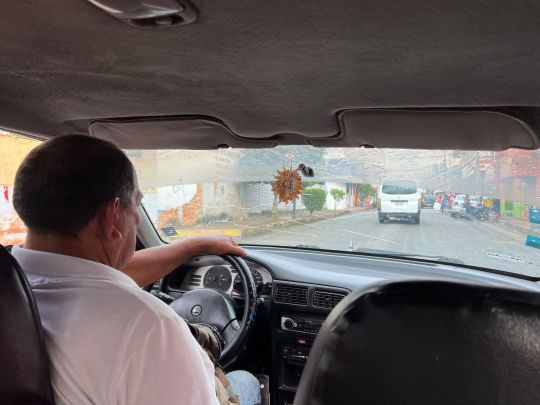
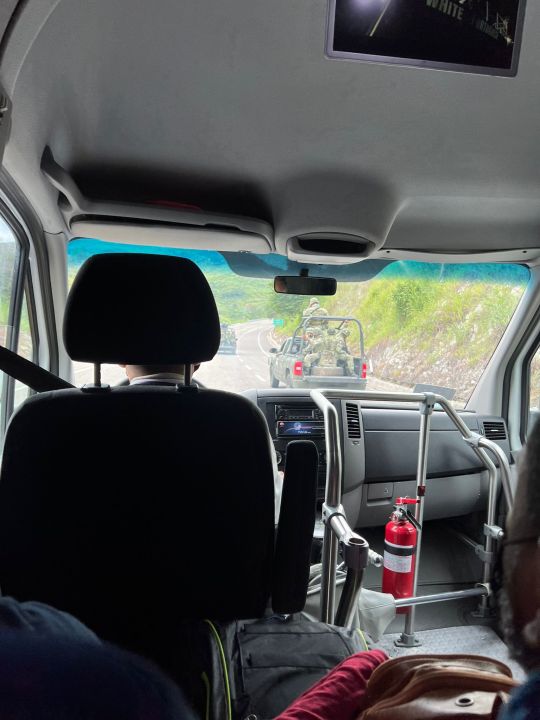
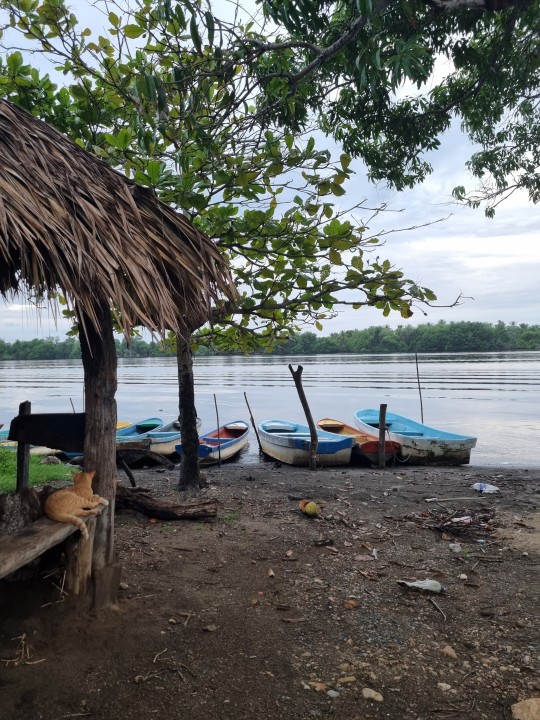
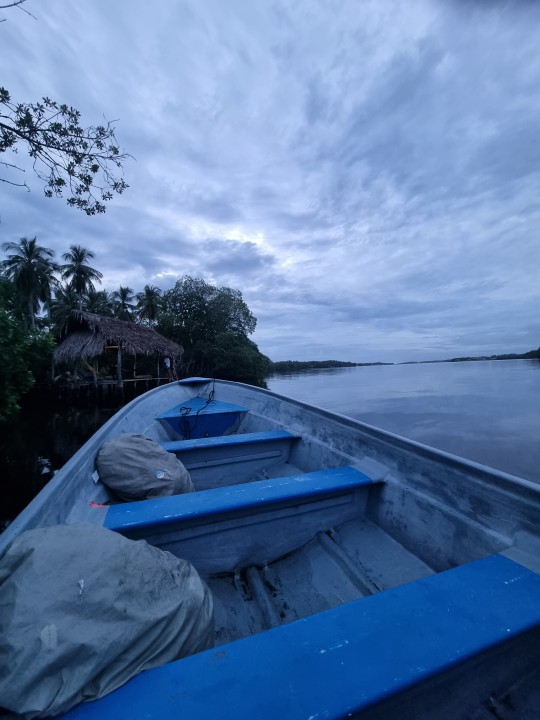
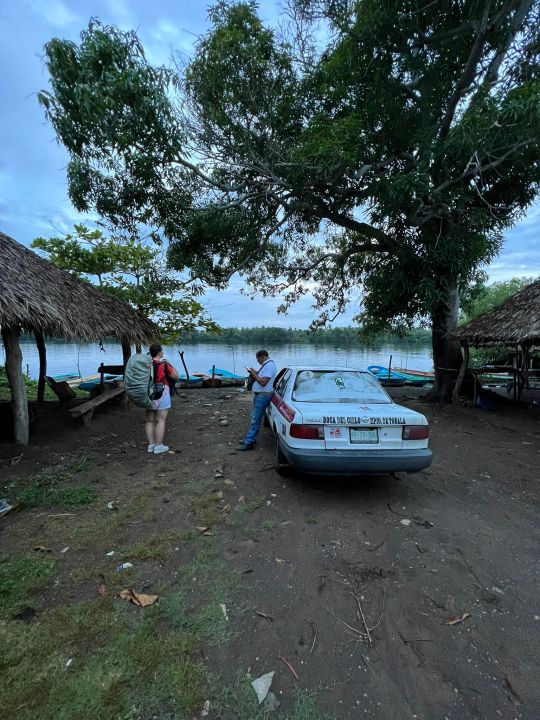
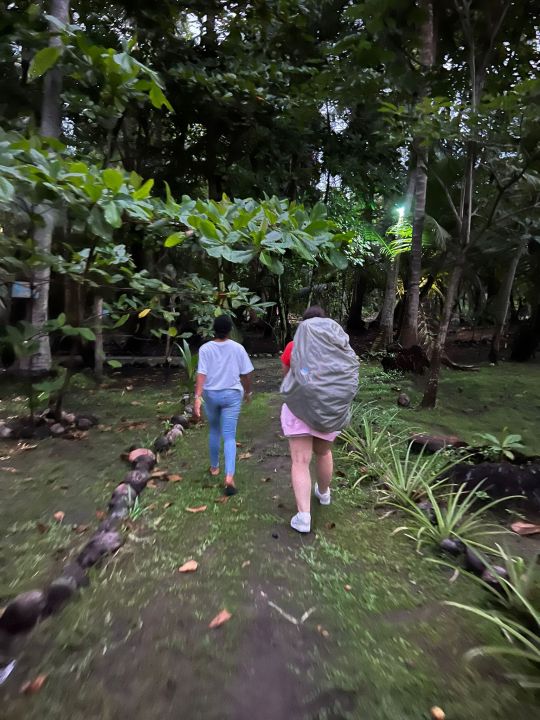
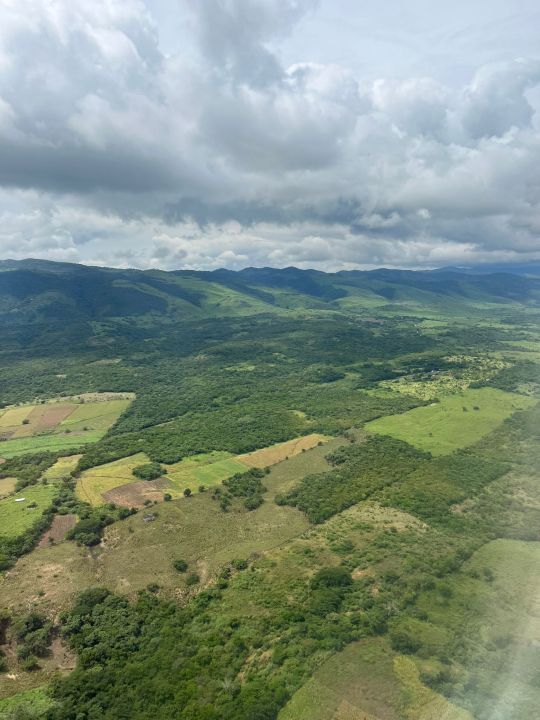
Arrivée dans le Chiapas
Ce matin on se réveille de bonne heure pour aller à l'aéroport de Mexico car notre prochaine étape est l'état du Chiapas. Réputé pour son caract��re indépendantiste (à la corse), on ne sait pas du tout à quoi s'attendre. On a lu tout et son contraire mais on retient que les habitants ici sont très attachés à leurs racines et coutumes amérindiennes, surtout leurs religions mayas et autres. L'état subventionne moins cet état que le reste du pays car il est considéré comme "contre le pouvoir". Donc on verra mais ça s'annonce intéressant.
On décolle à 10h15 ce matin direction la ville la plus importante du Chiapas : Tuxtla Gutierrez (500 000 habitants). Le vol se passe bien, en 1h30 on est arrivés. Vu d'en haut ça paraît très vert, montagneux. On prend un taxi (officiel de l'aéroport) vers la station de bus, à 40mn d'ici.
On a déjà nos billets pour un collectivo, à 15h pour Tonala, un "pueblo" plus au sud à 3h de route. Et oui notre point de chute se mérite : la rencontre avec l'océan pacifique dans un lieu retiré pour se reposer un peu.
La responsable de l' "hôtel" nous guide pour contacter un taxi une fois arrivés à Tonala, il sera là à l'heure (les mexicains sont super ponctuels). Une bonne chose de faite.
En attendant notre car, on en profite pour aller discuter avec une dame qui tient l'office de tourisme et savoir si ça le fait de conduire dans le Chiapas (car on était pas chaud vu les routes et les recommandations), pour savoir si c'était mieux d'annuler notre réservation de voiture.
Elle nous a déconseillé pour nos itinéraires car certaines routes peuvent être bloquées par des fonctionnaires manifestants pour un meilleur salaire, des blocages plus importants (imposant de faire des demi tour de plusieurs heures), et qu'il valait mieux trouver un point de chute et une agence qui gênerait nos déplacements.
Ok elle nous a bien rassuré du coup on annule la location et on prend le plan avec ses notes pour potasser tout ça.
Dans le collectivo, on voit bien que les routes sont dans un sale état et on croise plusieurs voitures militaires avec environ 5 militaires super armés debout à l'arrière, ça rigole pas.
2h30 plus tard, nous voici à Tonala. Le taxi est bien là mais l'état de la voiture laisse à désirer... Carglass en PLS à la vue de son pare brise... allez on en a pour un peu moins d'une heure pour rejoindre l'embarcadère "El Paso". Entre temps on récupère un autre passager pour le déposer un peu plus loin.
Le long de la route on croise de nombreux venezueliens qui traversent le Mexique pour arriver aux USA.
Heureusement qu'on a des autocollants de Jésus partout sur les fenêtres parce que je donne pas cher de cette voiture.
Robin me fait remarquer "il a même pas d'aiguille sur son compteur" (voir photo).. pas de compteur, pas de dépassement de limite de vitesse.
À l'heure prévue on arrive, et la lancha (petit canoë en bois) apparait avec Julian à bord.
On embarque pour 5mn sur la Joya avant d'arriver à Entremares, notre point de chute pour les 3 prochaines nuits.
On découvre notre cabane, Chachalaca et la proximité avec l'océan ; 1mn de marche. Un bien fou après une ville comme Mexico !

0 notes
Photo
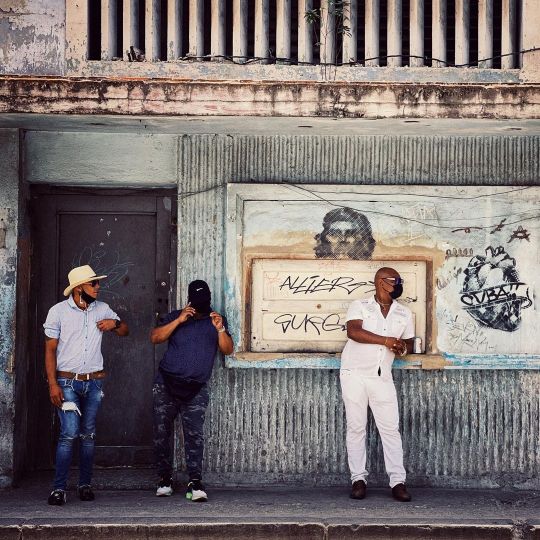
Corner of Neptuno and Consulado - I love this corner. I could probably do a show from the pictures I’ve taken on this corner. Collectivos (Cuban Taxi) Cafe, bici taxi, and the segway to Centro Habana. You can learn a lot about life in Cuba while people watching on Neptuno. #havana #cuba #centrohabana #streetsofhabana #streetphotography #allwaysiphone (at Centro Habana, Cuba) https://www.instagram.com/p/CeK2nc_Ohu9/?igshid=NGJjMDIxMWI=
1 note
·
View note
Photo
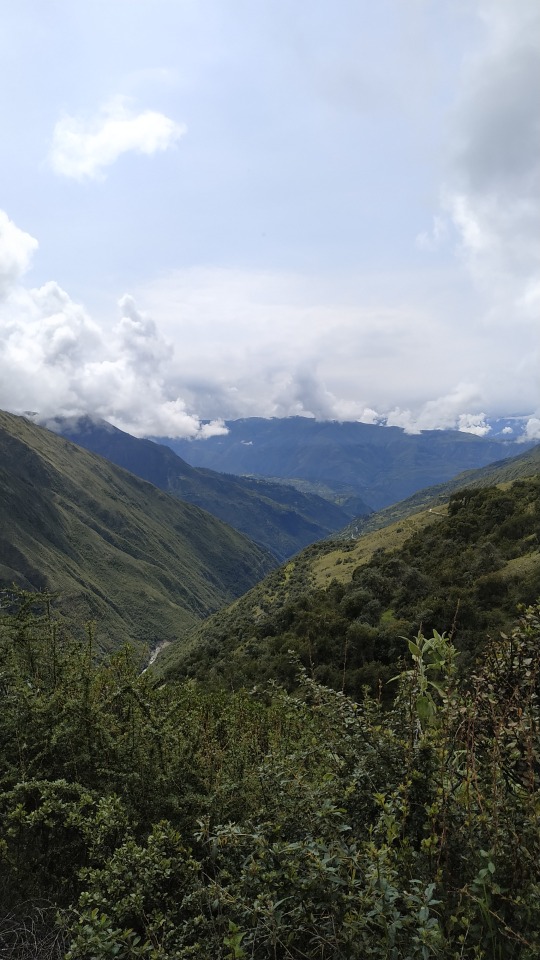
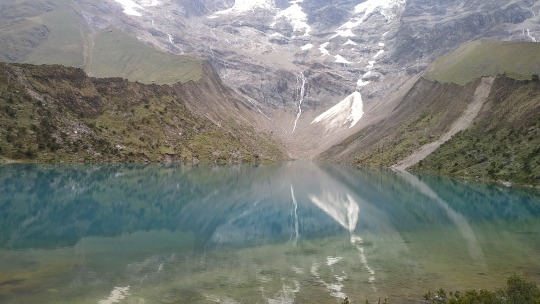

Salkantay trek, jour 1
Deux jours avant le départ : Je ne suis pas en forme, j'ai du mal à monter des marches, il faut que je m'arrête pour respirer. Si ça continue comme ça, je ne pourrais pas faire le trek.
Veille du départ : Je me sens mieux mais je doute encore, le trek est très difficile, il y a beaucoup de dénivelés, il faut marcher longtemps tous les jours et tout ça en altitude, je ne sais pas si j'en suis capable... J'ai quand-même très envie de le faire. Le soir il pleut énormément, il va en plus y avoir de la boue. J'ai du mal à m'endormir.
Jour du départ, 3h40 : Le réveil sonne, j'ai pas envie. Il est un peu tard pour faire demi tour. On s'habille et on trouve un taxi qui nous amène au bus. C'est un collectivo, ce qui veut dire qu'il ne part que quand il est plein, je m'endors avant le départ et pour la plus grande partie du trajet. Je me réveille au milieu de paysages magnifiques, on est déjà très haut.
Le trek commence par une montée, je vais lentement et tout va bien. Le reste est du presque plat, avec une superbe vue sur la vallée. On arrive au campement à 11h30, du coup on monte la tente et on y laisse nos affaires. Il vaut mieux parce qu'une grosse côte nous attend ! J'ai vraiment du mal mais j'arrive finalement en haut où il y a un lac turquoise au pied d'un glacier, c'est vraiment très très beau ! On y reste un petit moment avant de redescendre se reposer.
#travel#south america#americalatina#peru#landscape#trek#salkantay to machu picchu#salkantaytrekking#glacier
3 notes
·
View notes
Photo

People always ask me how I get around when I go on buying trips to Mexico. I don’t rent cars anymore (had a car accident in Michoacán a few years ago 🙄) but I do take lots of taxis, the Metro, little buses known as collectivos, and these amazing, well run, efficient buses. Today the electricity was down at the Mexico Norte bus terminal so passengers were instructed to purchase tickets on their phones. We did so and the bus still left on time and arrived early in spite of the problems with the computer systems! (at Autobuses del Norte) https://www.instagram.com/p/ByykGgvFZ6N/?igshid=osujujot3k53
1 note
·
View note
Text
POPTÚN 1/2 | GUATEMALA
Die Finca Ixobel liegt 5 km ausserhalb von dem kleinen Ort Poptún. Sie ist 161 Hektar gross, mit viel Wald & einer grossen Höhle! Es gibt neun Pferde, mehrere hundert Hühner, drei Hunde, viele Katzen & noch mehr Zecken (zum Glück ohne Borreliose). Carol, die Besitzerin, ist eine US-Amerikanerin, die seit den 70er-Jahren diese Finca aufgebaut hat. Schon seit den 80er-Jahren arbeiten hier immer wieder Volunteers. Wir werden von Petra, einer Deutschen, die seit 14 Jahren da ist, empfangen & im Gelände herumgeführt. Der Deal: morgens 6 Stunden arbeiten, 5 Tage die Woche, 2 Tage frei, Privatzimmer im eigenen Volontär-Bereich, gratis Nahrungsmittel zum Selberkochen, unlimitiert Kaffee/Wasser, gratis Touren. Auch andere Sachen wie Wäsche waschen ist alles inbegriffen. Ein sehr grosszügiges Angebot! Mit uns ist noch eine andere Volontärin hier, Daniela aus Brighton.
Unser erstes Projekt: eine Holzhütte & die Möbel neu streichen & lackieren. Wir freuen uns, einmal handwerklich etwas machen zu können. Unsere ersten beiden Freitage verbringen wir damit, die Umgebung zu erkunden. Da wir vor der Semana Santa (Woche vor Ostern), in der alles überfüllt & ausgebucht ist, noch nach Flores & Tikal wollen, planen wir diesen Ausflug gleich für unsere zweite Woche ein. Wir fuhren mit dem Collectivo zum kleinen Ort El Remate, am Lago Petén-Itza, dem drittgrössten See Guatemalas. Es ist wunderschön da, & wir können endlich wieder unser Zelt für zwei Nächte aufschlagen. Von da aus ging’s dann zu der bekannten Ruinenstadt Tikal, mitten im Dschungel. Für uns die bis anhin schönste Ruinenstadt, die wir besucht haben. Wir schlendern einige Stunden durch den Park & genossen den schönen Ausblick von der grössten Ruine. Zurück in El Remate geht es direkt in den erfrischenden See mit klarem Wasser. Am Morgen unserer Rückreise besuchen wir noch die kleine, bekannte Insel Flores, doch wir verstehen nicht, wieso da alle hinwollen. Nichts sonderlich Schönes, anscheinend ist es da einfach gut zum Feiern. Wir sind froh, nicht dort übernachtet zu haben & fahren wieder zurück in die Finca.
Eine lustige Geschichte: Wir bestellten ein Taxi um zu einem nahegelegenen Fluss zu fahren. Der Taxifahrer war ein alter Mann mit einem alten Auto, den die Leute von der Finca schon lange kennen. Er fuhr uns dahin & wir machten eine Zeit ab, wann er uns wieder abholen kommt. So weit so gut. Zu abgemachter Zeit kam er auch pünktlich da an, war aber ziemlich betrunken. Nach einigen Metern überliess er also kurzer Hand Flavio das Steuer. Bei einer Tankstelle insistierte er, dass wir etwas mit ihm trinken. Als er schon fast etwas laut & hässig wurde, machten wir das dann auch. In der Finca angekommen, traf er per Zufall ein paar Gäste, die er kannte & mit denen er gleich noch weiter trank. Wir hatten die Rückfahrt noch nicht bezahlt, & wollten dies auch nicht unbedingt tun, doch nach einiger Zeit suchte er uns auf & wollte natürlich sein Geld. Wir zahlten, & die Mitarbeiter der Finca löschten ihn von der Telefonliste.
Drei Wochen sind schon vorüber, bleiben noch 3 weitere... :-)
DER WOHNBEREICH

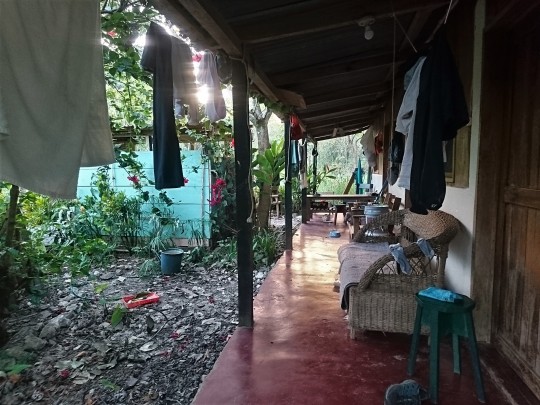
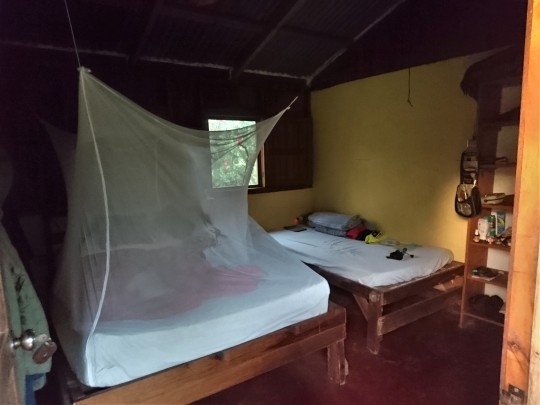
DIE UMGEBUNG

Lagune auf dem Gelände, nur für Gäste & für uns
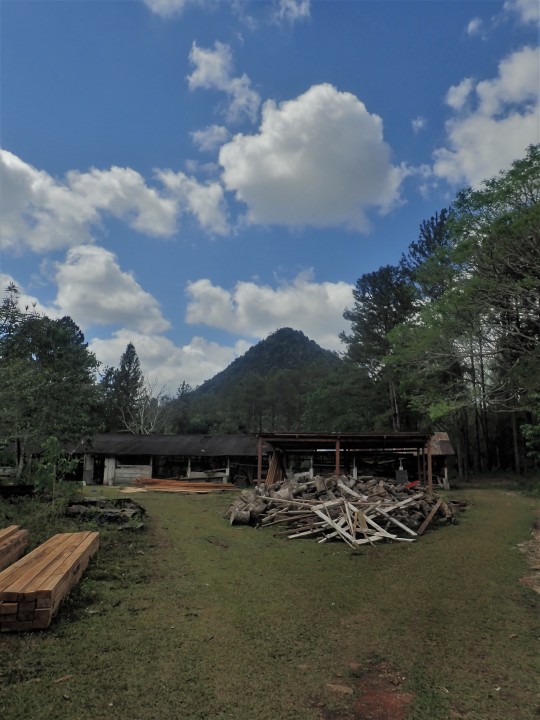
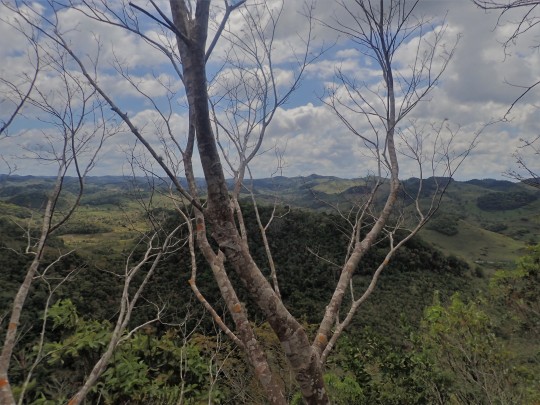
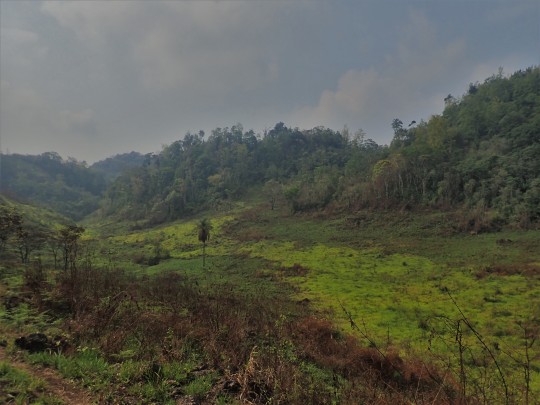
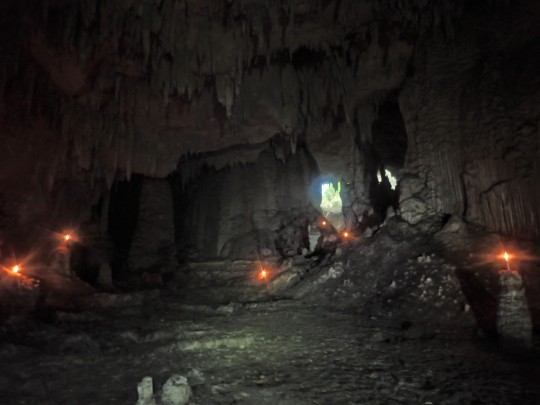

Cueva Ixobel
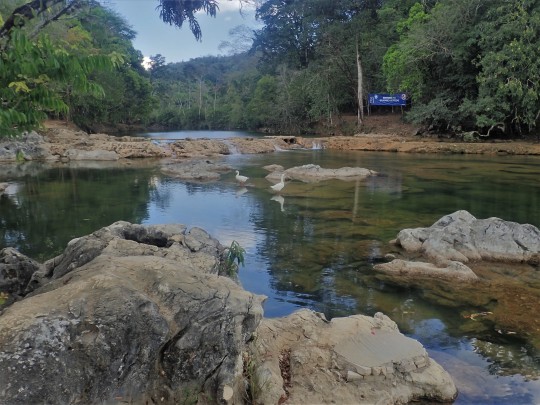
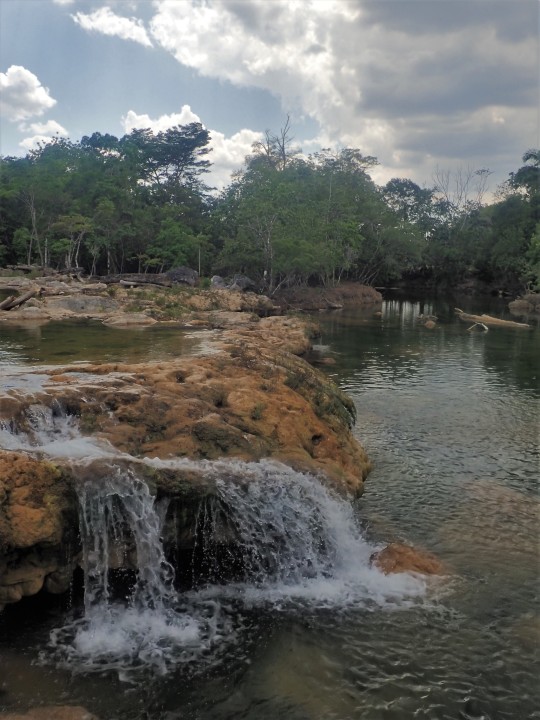
Las Pozas
EL REMATE / TIKAL


der bekannte Templo del Gran Jaguar von hinten (ohne Leute ;-))

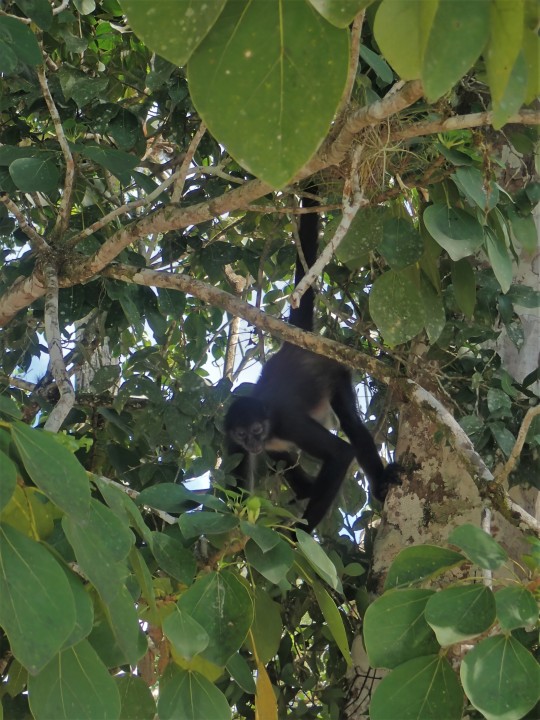
Klammeraffe
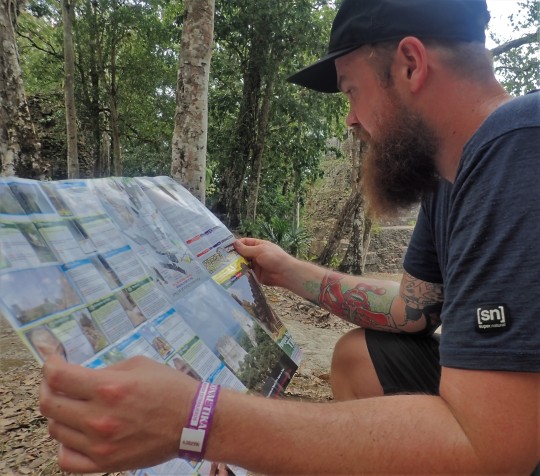
unser Tour-Guide

Lago Petén-Itzá
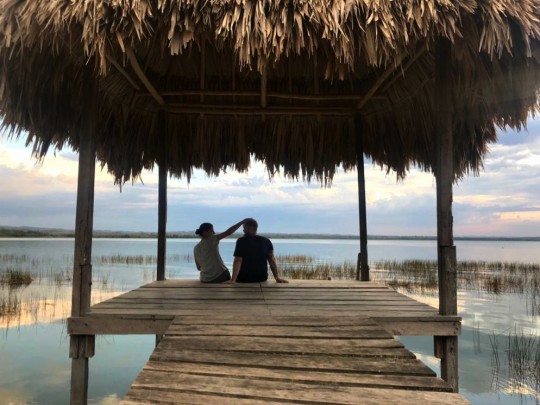
1 note
·
View note
Text

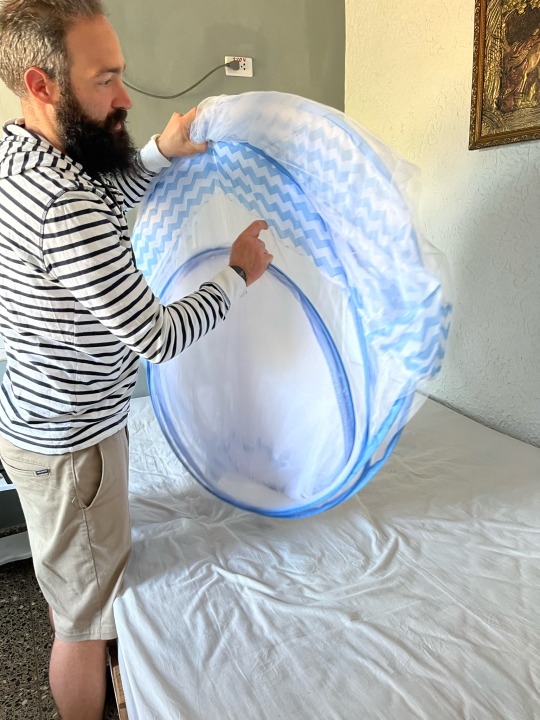
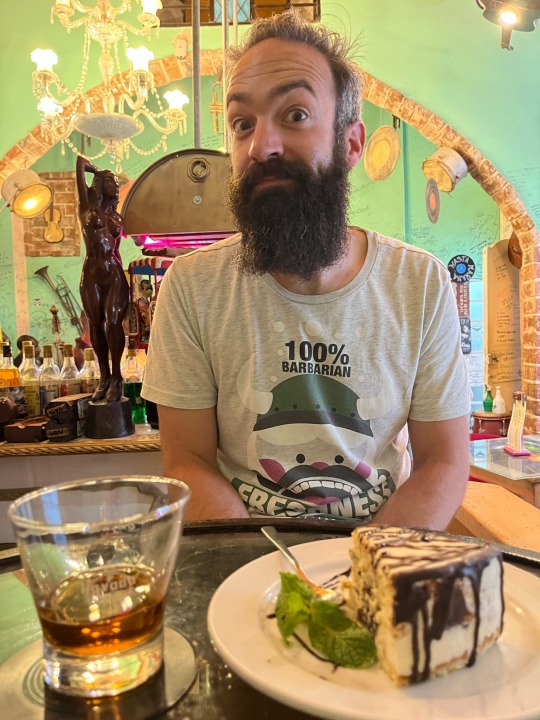
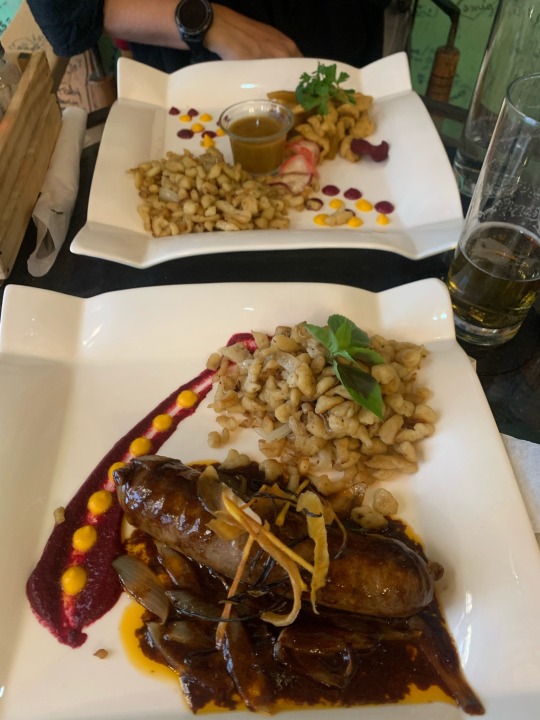

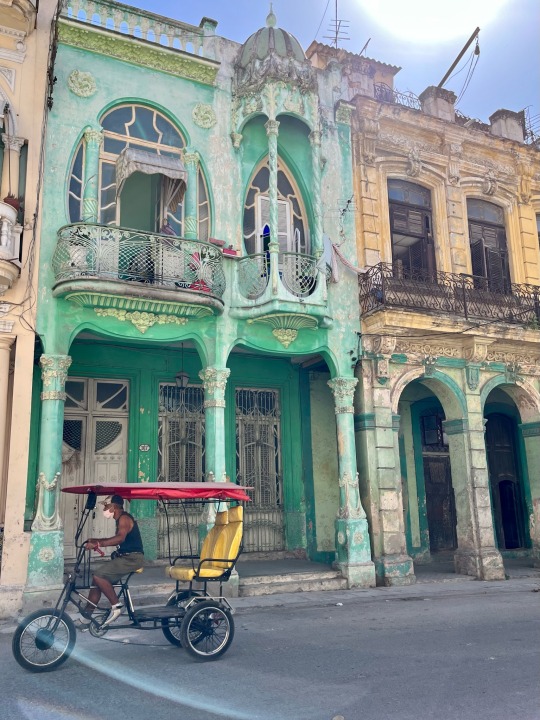

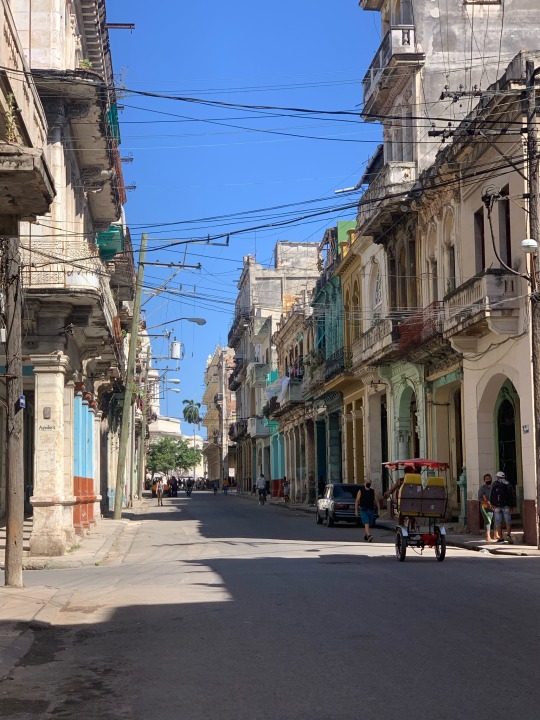

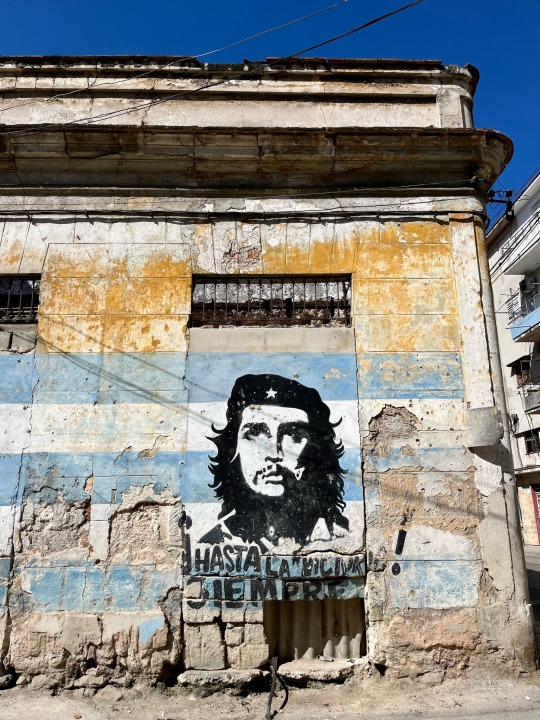
Dia 8 y 9:
Dernier petit déjeuner avec Marylin, on profite de ses fruits et ses crêpes car les deux prochains jours, sont des jours de transferts pour passer de l’autre côté de l’île. Les transferts ne sont pas nombreux à Cuba, bus ou taxi collectivo.
On remballe nos affaires, on repli pour la première fois notre moustiquaire et une heure plus tard (environ le temps que ça nous a pris 😂😂) on est prêt pour dire adios à notre hôte adorable.
On décolle à midi pour retrouver 4h30 plus tard Adonis à La Havane où l’on fera un stop pour ce jour.
Le bus n’est pas du tout confortable et a vraiment pas mal secoué notre marathonienne enceinte, on pose donc nos bagages pour une nuit ici avant de repartir demain pour un autre périple en bus vers Cienfuegos.
Le temps de faire un petit tour de notre quartier et on se pose dans « Van Van », un bar musical très connu du quartier ou l’on recharge nos batteries et on rempli notre ventre. Thibaut avait besoin d’un voire deux « destressant(s) » Allez on rentre se coucher, La Havane s’est assombrie, et demain on a de la route.
Au matin, c’est Helena qui nous réveille avec ses découvertes culinaires aux réveils. Elle a décidé de nous faire connaître les différentes curiosités exotiques de son île. Ce matin: la « Mamey »… inconnue au bataillon en France. Comment la décrire… une chair orange similaire à la patate douce mais plus sucrée et plus charnue. Très bon mais une Mamay a deux et on a fait Peter le score d’indice glycérique 😱😀😋. On en ressort rassasié et prêt à arpenter les rues de La Havane.
On prend donc la direction du quartier chinois de la ville… bon, pour dire vrai… rien, de ce que l’on a vu ne pourrait faire penser un seul instant à la Chine, mais toujours des bâtiments à l’architecture incroyable, témoignant de la splendeur passée de La Havane, malheureusement aujourd’hui dans son jus, faute de moyen pour les réhabiliter. Comme un peu partout ici… Cela nous fait beaucoup réfléchir sur leurs conditions de vie extrêmement compliquées dans ce régime.
Allez, direction le terminal de bus, véritable aéroport Cubain, où l’on part pour Cienfuegos, ville côtière du sud de Cuba. Ville natale de Camillio, personnage important du pays, que les cubains nous mentionne régulièrement par ses ressemblances avec Thibaut. La barbe n’étant pas très commune à Cuba, il en faudra pas plus pour lui trouver des points commun avec Camillio, Che Guevara ou Fidel Castro.
5h30 de voyage plus tard, on pose nos sacs chez Alejandro, très heureux de nous rencontrer et il nous le fait savoir. A peine débarqués, il nous mets à l’aise en nous proposant ses cigares, vieux Rhum et son propre café pour Élise (il est 20h 😅).
Il n’y a pas à dire, les cubains ont un sens de l’hospitalité ancré dans leurs gènes. Il nous indique une de ses bonnes adresses de restau où ses copains s’y produisent en concert.
Après cela… un cigare et un rhum avec notre hôte et au lit, on ne voudrait pas manquer notre visite de la ville demain. 😀
Hasta luego todos 😘😘
1 note
·
View note
Text
Max, Tag 37
Boot, Boot, Wasser, Wasser
Nachdem mich aus unerklärlichen Gründen mein Wecker gleich mehrfach gegen fünf aus dem Schlaf riss, döste ich noch ein bisschen weiter. Irgendwann waren aufgrund der Helligkeit dann aber alle Versuche vergebens - aktuell gibt es ungefähr 20 Stunden Tag und vier Stunden Nacht. Zum Frühstück gab es die Reste der Nudeln mit Gemüse, die ich mir gestern gekocht hatte, die merkwürdig süß schmeckten. Selbst eine mehr als großzügige Zugabe von Salz löste das Problem nicht, machte es irgendwie fast schlimmer. Als ich mir die Packung bei Tageslicht ansah, könnt ihr euch denken, welche Beschriftung ich entdeckte.
Danach bin ich zum Friseur gegangen. Hätte ich gewusst, dass das hier jedes Mal so ein Erlebnis ist, hätte ich direkt eine Studie verfasst: dieses Mal schnitt mir ein Italiener um die siebzig die Haare. Er war etwas heruntergekommen, trug langes graues Haar. Sein Salon, in dem ein kleiner Hund unerlässlich kläffte, war optisch irgendwo zwischen Gebrauchtwarenladen und Dr. Frankensteins Labor. Dazu lief lauter, straighter Techno - zum Tanzen während des Schneidens war er sich auch nicht zu schade. Ich fand das toll. Auf der Suche nach einem Ticket nach Porvenir wurde ich dann am Hafen abgewiesen, ich müsse zu einem anderen, mit einem Collectivo der Nummer 15. also wartete ich. Mich passierten die 1, die 6 und die 8. Immer und immer wieder. Irgendwann war ich genervt vom Warten und dass alle Leute irgendwann ein Taxi nahmen, ermunterte mich auch dazu. Bis ich mir mal wieder unendlich dumm vorkam, als ich verstand, dass die Nummern auf den Dächern der vermeintlichen Taxis keine Firma, sondern eben eine Linie repräsentierten. Nach zwei Minuten kam auch die 15 wieder. Wie viele ich vorbeiziehen lassen habe, weiß ich nicht. Jedenfalls brachte es mich zur Fähre. Boot fahren, ihr wisst, was ich davon halte. Dieses Mal gab es darauf sogar Essen und ich kann mit Fug und Recht behaupten, das mit Abstand schlechteste Sandwich meines Lebens serviert bekommen zu haben - und das muss man erstmal schaffen! Dennoch bin ich wohlbehalten in Porvenir angekommen, das mir sehr gut gefällt. Weil es Schottland ist - 1:1. morgen hoffe ich aber auf meine Pinguine. Wenn ich sie sehe, bin ich happy und kann Feuerland guten Gewissens Richtung Torres del Paine verlassen. Bin ich nicht erfolgreich, bleibe ich noch einen Tag. Ihr werdet es erfahren!
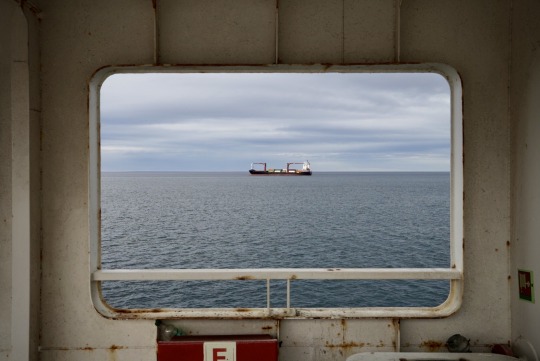
2 notes
·
View notes
Text
The Guides rideshare in Mexico's Collectivo Taxis | Travel Guides Australia
https://www.travelonlinetips.com/the-guides-rideshare-in-mexicos-collectivo-taxis-travel-guides-australia/
The Guides rideshare in Mexico's Collectivo Taxis | Travel Guides Australia
Videos #Videos #travel #love #photooftheday #nature #photography #instagood #travelgram #travelphotography #travelblog #travel #travelgram #travelphotography #wanderlust #instatravel #travelling #travel #travelgram #photooftheday #travelphotography #trip #instatravel #foodandtravel #foodie #foodporn #food #foodblogger #foodphotography #foodies #foodiesofinstagram #travel #foodpornshare #sogood #travelonlinetips #MarkWeins #holiday #vacation #staycation
0 notes
Text
part 1
Septiembre, Octubre & Noviembre
Hace 9 anos.
Now that I’ve spent six months in South America, its time to record the thoughts and impressions of this past half year while they are still clear.
Unsurprisingly, the first months were the strangest, because we were viewing this new place through Western lenses without realizing our biases.
Huarmey, our first temporary home and job placement, would prove the perfect place to shake us from our preconceived notions.
It’s a city I will always remember with appreciation, and I now cherish my memories there. I don’t know if I can say the same for my traveling partner Cam, but he now speaks of it fondly at least. When we arrived, back in September 2012, there were many unpleasant surprises. This will always be the beginning of the trip to me; but I’m getting ahead of myself. Let’s start at the true beginning.
Upon arrival in Lima we take the mandatory thirty minute cab ride to the Barranco district at ten at night. Almost worth enduring a horrible international flight: your first quick view at your new environment zipping past. A flashing preview of what you will be savoring at a slower pace in the days to come, something I had experienced many times but was experiencing now with Cam for his first.
Lima became one of my favorite cities. A lot of travelers think it’s dirty, big and annoying. Which it is–but it also has a lot of character. There are different feelings to each barrio, but they all have wonderful food. The city bustles with the activity of its residents, who love their city inside out. The city has had to be rebuilt several times due to earthquakes and many building being from colonial times. It’s broken and crumbling but is loved by its residents. The decay is beautiful in its own way. It’s also the perfect starting point for adventure in the lung as of South America (Perú).
On our way to Huarmey we stopped in Caral, location of the oldest known civilization in the Americas. Since the path here is not well-beaten (as is the case with many other ruins in Peru) it proved a good primer for the art of traveling in this part of the world. We jumped through what at the time felt like a ridiculous amount of hoops. Little did we know this would become our regular lifestyle. A bus to Barranca, a confusing moto-taxi (motorcycle taxi) to an alley way, a few convis (vans that function like buses), and a hop into a station wagon parked in a random garage (these are ride shares called collectivos) and just like that we’d arrived. The whole thing is very rushed yet no one is in any real hurry, the whole process is not help much by my beginners Spanish.
This is also my first time experiencing another sensation which is now very familiar. It’s difficult to express, but it’s the sadness and confusion of seeing people living in extreme poverty, in the shadow of important world heritage sites, despite the presence of tourists and the money they bring. The village outside of Caral was one of the worst I’ve seen in South America, consisting of dirt paths instead of paved roads filled with piles of garbage which was sometimes burning, run-down futbol fields and plazas, broken power lines and mud-huts. Caral isn’t the biggest tourist destination despite its historical importance, but money is being spent, and little to none appears to make it to the struggling community living just outside.
Still, Caral is an impressive site. It’s nothing quite like the perfectly preserved, glorious ruins in the Sacred Valley around Cusco, yet it’s a relatively well preserved precursor to the Incan empire. For anyone curious to feel the energy of ancient places or interested in history, this site holds a lot of impact. The lack of tourists as well make the site meditative. But it’s north of this ancient relic where our real destination lies, and where the story progresses.
Huarmey! A real gem—for those who are really willing to dig through a pile of shit to find it. The town is growing into a small city, with little charm for the eye. Its bustling streets are littered with rubbish and incredibly loud Latin beats. We came here to work in a hostel and stay for free, but the moto-taxi ride from the bus station alone made it very clear, we would not be having many clients.
And we did not have a single client for a month. While this was disappointing, it allowed us to have a much more fulfilling experience teaching English to local children, which after six months remains to be the largest impact we’ve made here. Jaime Crazy Hostel in Huarmey advertises itself as a ¨non-profit¨ organization online. In person we found absolutely no proof of any such activity.
I can’t continue this part without introducing one of the best, most genuine friends we’ve made on this trip, Charles Severin. He’s French and lives up to the name. With much help from Charles we set up our own English classes with the local kids—after finding none despite the fact they were supposed to be provided.
The classes for the next month unfolded beautifully, with the most attentive, responsive and quickest kids I have yet encountered. But here the logistics start to get messy due to a man named Percy (represented to us as the ¨brother¨ of the hostel’s owner, Jaime) who is helping run the hostel, and who also had Ana (a lovely Peruvian woman we live with) charge the kids one sole a piece as a registration fee. This exchange was made behind our backs, the volunteers who created the program. Percy begins to pressure us to charge new volunteers who wish to teach English, though it is advertised as free on Helpx and the hostels website. It quickly becomes very clear that providing these English classes isn’t of much interest to the hostel unless it’s making money for Percy. Suspiciously, we never met this Jaime and he never visits the hostel, but we see Percy frequently.
Mainly due to Charles resiliency, we never charge anyone anything and continue the English classes. Percy tries to convince us that we should go to Lima to attract tourist to Huarmey, of course we never due this. We tried our best to set the program up so that it may continue once we leave, because the student were making excellent progress and it would be such a shame to see it have to end.
This continued for an awkward month but by the time we’re set to leave we find it’s been worthwhile. The kids have learned a lot, we hear them using English words on their own and they are able to use and understand pronoun affiliations and use basic English skills without Spanish explanation. Charles has also managed to set up a system in which the classes are able to continue without us, hopefully. I was happy to leave Huarmey but do so with mixed feelings, curious about what will become of our efforts—and what could have been. Watching the Peruvian Pacific coast as we return to Lima is very nostalgic for me, always having grown up on the Pacific side of my own country. But I am excited to continue into the Southern Andes of Peru. We will definitely miss Charles, that quirky, sweet Frenchman out to change the world of seven billion however he can.
Back to Lima for a short while just before exploring heading south and again it’s lovely. The people, the protests, and the food! But we are out for an adventure in Arequipa a pleasant enough city but the real draw here is nearby Colca Canyon. A well enough beaten path that one can hike and stay in the canyon for at least three days alone.
This is probably one of the best hikes to do in Peru. The first days are long and hot but very good exercise and easy as long as you have enough water and sunscreen. Available huts and camping spots are nestled in breathtakingly gorgeous, if scary, spots on cliffs and on the edge of rivers. We were able to extend this trip by befriending a kind Peruvian man who operates a hostel called Pachamama, in the village of Cabanaconde, which serves as a launching point to the canyon. He trusted us enough to lend us a hundred soles we could repay in Arequipa.
There are small communitied to see within teh canyon while you hike through, the curving path is always providing excellent views and new angles of the canyon. Its dry like a desert, the sun scorches you like a desert yes much green activity is nestled within. Still, our mistake was in not bringing enough water. The last shortest day is the most challenging, a very steep and hot four hours. If it had not been for a group of Canadians and a sweet fellow Californian we joined on the trail and the water they shared with us, Cam and I are not convinced we would have made it. We continued on with this lovely bunch to our next long-term destination, Cusco and the Sacred Valley of the Incas!
Cusco held us much longer than expected. Our first enthusiastic day there was colorful as we stumbled upon El Barratio, the best second hand goods market we’d found in South America. A market full of locals, antiques, second-hand everything and anything. Here you find cows butchered in the open, dried llama fetuses for sale, fossils and the unfortunate sight of children using the street or train tracks to relieve themselves.
We also quickly find out this is one of the easiest places to get robbed. Cam’s pocket was picked within our first hour. We learned from our mistakes. On another occasion in this same market, I have about four people each attempt to rob me with every trick in the book. Spitting, crushing my shoe-heels to keep me from moving, crouched old women simply reaching into my pocket; all without success. Oh Barratio, place of real experiences.
A half an hour outside of Cusco into the valley is where we call home during our time here and will forever feel welcome. Huambutio they call it, and we live in La Hacienda, an old monastery with a chapel, inhabited by a crazed monkey on a chain, a chupa-cabra and various hippies and volunteers passing through.
Within our first week our new boss Enrique is off, leaving us in charge of the house for the rest of the month, but not before we are pleasantly surprised with the arrival of Charles!
Left behind by Enrique, reunited with Charles and joined by a volunteer coordinator younger than any of us (and more New Age than we’ll ever be). This bright, spiritual soul, bringing fresh insight if little structure to the actual coordination of volunteers, goes by the name of Kayla. Which works out better for us, we got a lifelong friend rather than a mere associate at Suyai Wari, our cultural center.
Many people passed through Suyai Wari during our time there, but the ones with us the whole time, our true companions in the adventure, would be the couple of Karishma and Diego–soon to be three! Karishma was born in England and raised in the United States is now living in Peru with Diego, a French-born Peruvian. They made the most beautiful, loving, fantastic couple and I can only imagine the remarkable child they will have. I can’t wait to meet her. We spent most of our time in the house with them, laughing, sharing deep thoughts, and smoking Peruvian green—oh, and cooking! Everyone to come to this house was a good cook. But Karishma was our mamacita and Kayla provided healthy and always unique baked goods. It was a wonderful two months, and the virtual opposite of Huarmey.
Our work here with kids was well set up, but the difference we could make was limited. Every morning at the local school we worked under the unforgiving eye of a woman named Natalia. This was a very unpleasant experience as her concern was not in improvement of the students, but getting through the material as fast as possible. She also couldn’t speak English, despite being the district’s English teacher.
She was a bit horrible to the kids, which may be why they were horrible to us once she left the room. The other school we worked at was very small, quaint and pleasant. We spent good times with the kids but made little progress, sadly. Here we mostly taught and learned behavioral skills and how to work more efficiently with the most rambunctious of children.
Yet our experience living in Huambutio was the most comfortable we’ve found. We learned a lot about ourselves, New Age culture, the universe and the importance of human interaction. It proved a great place to make connections and learn lessons. We experienced feeling of love for other people and working together during hard times, including an eye opening experience of no water for two and a half weeks, something that cannot be taught in school.
Here we had to resort to retrieving water from the river to flush toilets (water that left behind a stench worse than what was there before), drawing water from a questionable man-made aquifer for dishes and boiling water from tiendas for drinking. The men worked hard to try and fix an exteremely questionable pipe, one Enrique decided to leave be before leaving us,which was rotting the side of our loving home. Our home which was made out of a lot of mud and the leak caused not only a seed to sprout in this mud but grow into a tree. Needless to say we all got very sick when there was no running water. While this is our state the house continues to fall apart with age and spring leaks. Daily you find bugs mating in the kitchen—they won’t go away because they find our compost delicious. The monkey escapes frequently sometimes attacking the women, including myself. Baby chicks disappearing by the day, and new volunteers showing up without any alert from Kayla.
With these lessons we met diverse and interesting people from all over the world along the way. Much love and thoughts were shared but one of my fondest memories was when Kayla, Cam and I saw Karishma and Diego off on their next journey. Right before we left they headed to Mexico and then to Florida to have their baby. At the convi stop we lugged all their stuff on the top, it was full of people on bottom and now it was time to say goodbye. We exchange hug after hug, kiss after kiss. Diego and I share a last long embrace, the silence lasts a moment as even the Peruvians occupying the convi are watching, and that is quickly broken by their abrupt calls of “oye! vamos!”
Remembering where we are we all quickly break away, Kayla tosses them their beloved charanga seemingly at the last moment and the convi zips away as quick as always. We watch them depart down the road as the sun sets. And I am reminded of how I watched Charles, Krystoph and Christian walk out the door, outfitted front to back with packs.
Our time here we were also able to experience the jaw-dropping ruins that (for lack of a better word) litter this area of Cusco, including Machu Picchu. We chose to go about visiting some of these ruins in an unusual fashion. With a group from Suri Wayi, beneath a full moon, we camped among abandoned ruins in the corn fields of Ollyantaytambo village, for the purpose of waking up in the middle of the night to sneak into the majestic ruins there, some of the most beautiful we’ve seen, the ruins of Ollyantaytambo.
Exploring by moonlight where Incans once had victory over the Spaniards was rather uplifting. The ruins rised and fell among the mountain sides, glittered with beautiful shape. Then, almost as soon as the sun rose the owners arrived, and we were busted. Being in Peru, no cops were called, we signed a document claiming we were not doing business at night, brought them some biscuits for breakfast and we, still sleepy but excited, were on our way.
We visited Machu Picchu in the cheapest (but an increasingly popular) fashion. We took a bus to Santa Maria, then took a collective along the most dangerous cliff we’ve encountered yet to a hydroelectric station; we trekked along train tracks, across a rickety breaking bridge and through sketchy tunnels, finally to reach Aguas Calientes. We spent a night here, feeling very out of place in this Disneyland-like town, we rose before the sun to begin a two hour hike through the jungle, to finally be rewarded by arrival at the pristine Machu Picchu. If this wasn’t enough for three days we continued to big Huayna Picchu. It was a gorgeous yet damp, hot and very sore day.
Cam´s visa in Peru is up and it’s either border hoping time or biting the bullet to pay one hundred thirty five dollar reciprocity fee to enter Bolivia. Facts are facts and we want to go to Lago Titicaca either way! So we are forced to venture to the unwelcoming rough city of Puno. Here I was greeted with a reality check, dished out by no one other than myself. After a bad bus ride which even a shared flask of vodka couldn´t alleviate, I left my precious leather purse in a moto taxi, along with my previous notebook of all this writing, Spanish school notes and the most expensive thing I´ve every purchased (other than my bike) an awesome canon camera with all my memories of Peru.
Puno will always be remembered here on as my closest thing to a mental breakdown. It was also very odd to hear myself speaking Spanish through tears; I couldn’t help regretting not learning enough Spanish yet to express myself properly in such an unplanned occurrence. It was a hard sort of tense that I had never used.
Cam and I stuck it out though. Or should I say Cam stuck it out with my crazed self, took a couple of hits and humored me while I insisted on chasing moto taxis and posting reward flyers around Puno for its return.
But enough screwing around. We moved on to the highly anticipated Bolivia and the next beginning. Leaving Peru on the bus to la frontera and Copacabana Cam had his own reality check, as if we had been having too much fun on this trip and needed to remember where we were and what the lives are like for those living in our play land. Cam on the highway to Bolivia saw a dead body on the side of the road. I somehow missed this, but recall only seeing Peruvian peasants gathered on the side of the street and, despite this being nothing out of the ordinary, finding the sight of them eerie.
I only glanced over but realized everyone was staring, the Bolivians and Peruvians returned to chatting but Cam seems speechless. He told me what he saw: a boy with a bloodied face laying face-down with his pants around his ankles. I felt fortunate not to have seen this; even writing it here makes me feel sick. We’re not stupid and can only imagine what happened, but we didn’t dare speak of it much.
I believe a lot of people feel sympathy for the poor out of a sort of social habit: you feel bad for those with less. But I believe this is misplaced sympathy. We should feel for the injustice the poor suffer, not the fact they are poor but what made it this way, and this isn’t just liberal cant. It is possible to distribute money efficiently to poorer communities in countries making money in tourism. It is possible to be underdeveloped yet have healthy, happy people.
This is much too grand of a subject to elaborate on with this one instance. But this is the single worst injustice plaguing humanity, the manipulation of poorer countries rich in natural materials or labor. The lack of control over one’s health and well being; the scarcity of clean water, access to a proper diet, and security. Having the opportunity for a better life, rather than having only a fate beyond your control
0 notes
Text
Transition
2 worlds, 2 realitys. Somehow that plane ride bridges the gap,
Getting here was actually pretty easy,though i may come through Mexico city next year. A brief overnight might be preferable to the Huatulco taxi experience. Shuffled through immigration, glared at by the ugliest woman agent yet(hey it was Sunday night and everyone else was partying the end of Dia de Muertos). Actually got the green light, the sniffer dog detected the walnuts in my bag, but i said"No, No food" so no check,and the agricultural inspector was easy too. Yes I had a jar of peanut butter and a bag of sprout seeds, but I neglected to tell them. Outside in the heat of the day the taxi mafia wanted too much so I walked to the road where the more organized drivers wanted 1800 p to Puerto. Got a collectivo(shared cab with 4 others) for 1200($100). I,d imagined we,d drop people off along the highway, but no we went to Mazunte, a 1 hour crawl , dodging drunks and dogs, to spill our extra people, then zoom to Puerto. Seems if a taxi tailgates and flashes it,s lights before racing the oncoming trucks, everything goes faster.
2 hours to Dans, and the key was under the rock as promised. Hot shower, quick snack (Pete and Jill had kindly put tortillas and eggs out for my arrival-delicious!) and a welcome bed in #3 cabana. I spent Monday unpacking my 20 kilo bag and 10 kilo carry on. Seemed OK till I dragged my garbage bucket of last years stuff out of storage(stinky stale clothes despite packaging in Big ziplocks), and the box I,d had to add on my return from MEX, and the beach umbrella, and the beach chair, and ... Bit of a treasure hunt dipping into the bin, and found that I had duplicated many small items. Looks like I,m good for razors and Q tips for some years!. Probably left them off my left behind list last year, thinking"Of course I,ll remember them!" However, clothes hung in the sun quickly cured, and the extra shirts and pants will go to the charity sale here. the corner store had fruit, granola,yogurt and juices, so all set.
Tuesday I went to the Banamex for cash and the machines liked me, then up to the supermercado for bulk goods, a 40 pound load. $1000 pesos! Somehow i packed it all to the highway and got a combi home. I waited till Thursday to go uptown for fruit and veg from the oh so busy wholesalers, another 40 pound set of bags. Lots of walnuts, almonds, cashews, for snack feeding , and a double bollio for a cheese and lettuce sandwhich. All in all i went way over budget.
What is my budget? Well I get $1800 a month pension, so that should be the limit, but since prices have shot up here just like home, I,ll be spending more. Have enough savings to cover the overruns. Mexico is no longer cheap, but it,s still affordable. With health insurance,tickets, and higher costs I,ll probably spend an extra $1000/month, but that includes a trip to Belize in March and the 1000$ for the dentist. I could find cheaper accomodation, but right now I,m up on a shaded terrace with a surf view, sea breeze, and a very safe place. Bath temp lap pool, big room and kitchen, privacy and good friends to chat with...it,s worth the xtra. As the value of the dollar slides against the peso there,s the hidden cost of inflation, but that also means my saving are depreciating, might as well spend the dough while it has any value.
Did i say it,s sunny every day, hot and bright? What,s that worth?
The sticky humidity and 33 degree temp has moderated after the roaring thunder and Gods flashbulb lightening, and hot rain, so it,s still hot but the sea breeze in the day and the mountain breeze at night keep it tolerable. I sleep under 3 fans, gradually decreasing the volume as the air cools, until first light(6am) when a sheet is cosy,
And i have a volunteer cat, skinny black and white howler who I foolishly fed and now seem to be an adoptive cat dad. Prefers chicken, eats yogurt, never seen an egg, but relents when no snacks are forthcoming. Wild? Sure likes being petted!
Enough detail for now. I,ll try to be more descriptive next time, less day to day. Adios!
0 notes
Text
Fin de soirée un peu galère et rythme très lent aujourd'hui... Hier finalement mon hôte était très en retard et du coup j'ai du aller dans un hôtel au dernier moment vers minuit soit un petit trou de 40 euros dans mon budget entre le taxi et l'hôtel.
Bon dans le prix le petit déjeuner est compris et je le déguste avec plaisir ce matin après une bonne nuit de sommeil. Il y a de la papaye fraîche, des bananes, une omelette jambon fromage, des toasts, de la bonne confiture et du thé limpton.
Je prends mon temps et je pars à pied avec l'employé qui m'a servi le petit déjeuner, après avoir posé mon sac à l'accueil. Il m'accompagne et je prends un taxi pour Sucupira.
Je m'installe dans un Aluguer, ou collectivo, le taxi brousse d'ici. Il faudra plus d'une heure pour qu'il se remplisse et atteigne son total de 11 personnes, un volume de de marchandises impressionnant et même une brouette dans le coffre.
J'en profite pour faire plein de photos de personnes du petit bout de marché frais qu'il y a dans le virage avec mon téléobjectif. Le trajet est assez rapide et je suis sur place un peu avant 13h.
La ville est inscrite au Patrimoine mondial de L'UNESCO depuis 2009 pour ses vestiges datant du XVe siècle. C'était la ville d'installation des colons et des esclaves qui par leur mixité ont créé l'essence même de l'actuelle ethnie capverdienne.
Je passe par la place où se trouve le pilori, témoin de l'époque de la traite des esclaves puis par le petit centre culturel où sont vendus des produits locaux souvent faits par des coopératives de villageois.
Je remonte ensuite la Rua Banana, célèbre, avec ses belles petites maisons peintes et leurs murs de soutainement peints en blancs.
Plus haut il y a l'église notre Dame de Rosario XVe siècle. Les murs sont blancs et les plafonds en bois sombres. Plus haut la vallée s'élargit et devient très fertile.
Je retourne vers le front de mer et m'installe pour déjeuner sur une terrasse chez Kaza Antù. Je commande un plat de poisson cuit au barbecue, du txitxarro, prononcez "tchitcharo" servi avec des légumes à la vapeur des frites et du riz. Le tout arrosé d'une caipirinha.
C'était délicieux et copieux et j'ai maintenant l'énergie pour monter tout au dessus du village jusqu'à la forteresse construite elle aussi au XVe siècle dès l'arrivée des colons pour se protéger des pirates anglais.
Je longe le port puis traverse la vieille cathédrale, en ruine, premier lieu de culte construit dès l'arrivée des colons. Il y a quelques belles pierres et quelques murs encore bien debouts.
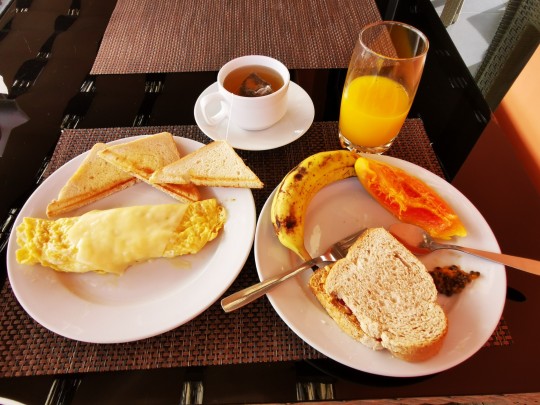

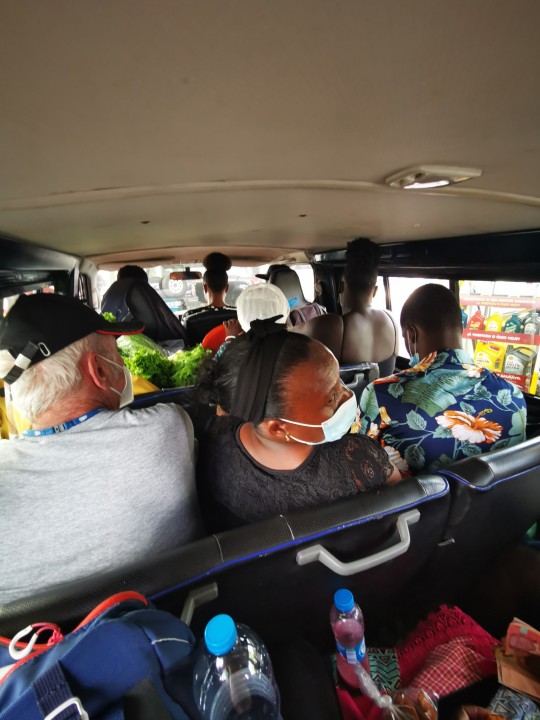
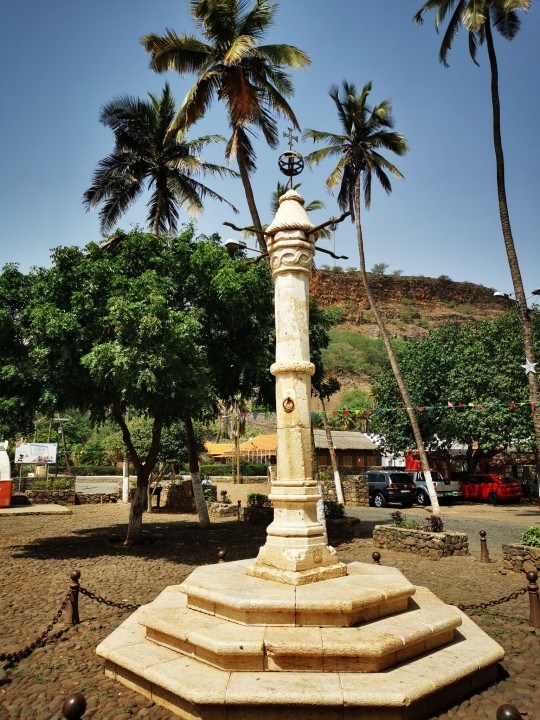
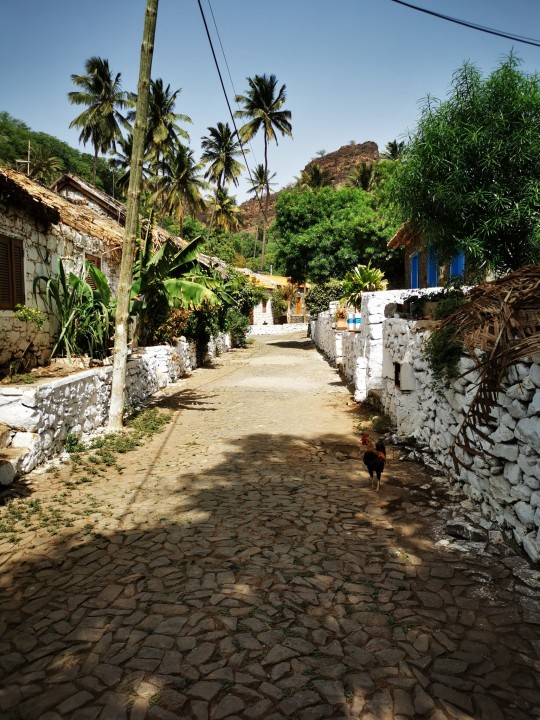
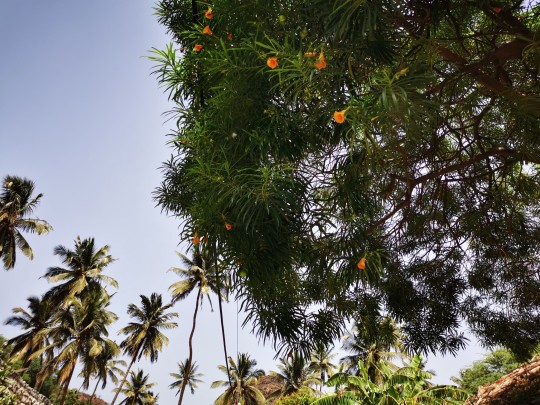


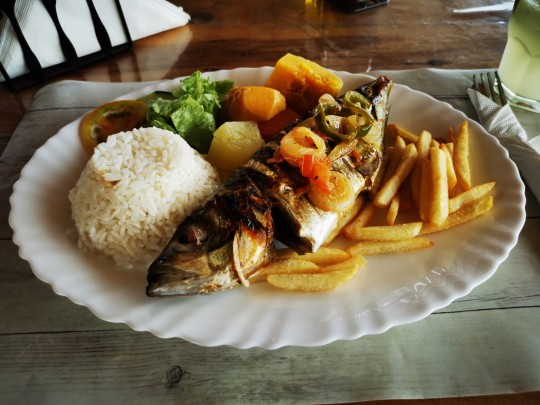
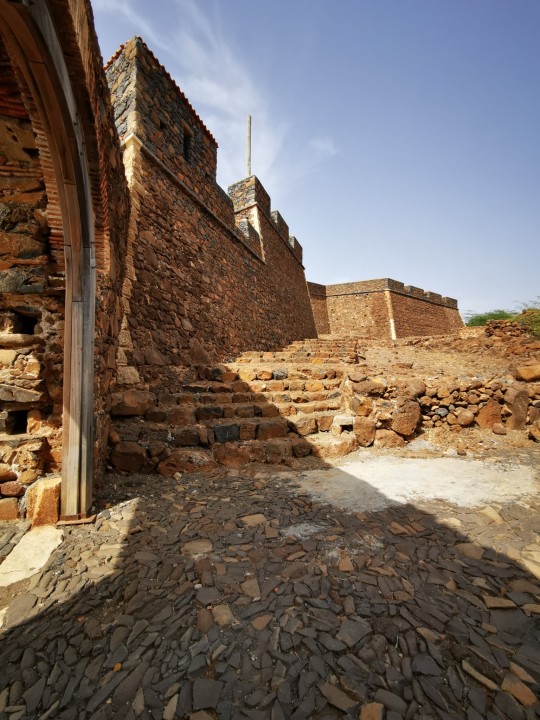
0 notes